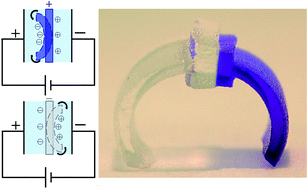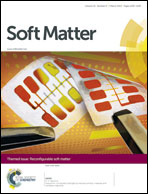Electro-actuated hydrogel walkers with dual responsive legs†
Abstract
Stimuli responsive polyelectrolyte hydrogels may be useful for soft robotics because of their ability to transform chemical energy into mechanical motion without the use of external mechanical input. Composed of soft and biocompatible materials, gel robots can easily bend and fold, interface and manipulate biological components and transport cargo in aqueous solutions. Electrical fields in aqueous solutions offer repeatable and controllable stimuli, which induce actuation by the re-distribution of ions in the system. Electrical fields applied to polyelectrolyte-doped gels submerged in ionic solution distribute the mobile ions asymmetrically to create osmotic pressure differences that swell and deform the gels. The sign of the fixed charges on the polyelectrolyte network determines the direction of bending, which we harness to control the motion of the gel legs in opposing directions as a response to electrical fields. We present and analyze a walking gel actuator comprised of cationic and anionic gel legs made of copolymer networks of acrylamide (AAm)/sodium acrylate (NaAc) and acrylamide/quaternized dimethylaminoethyl methacrylate (DMAEMA Q), respectively. The anionic and cationic legs were attached by electric field-promoted polyion complexation. We characterize the electro-actuated response of the sodium acrylate hydrogel as a function of charge density and external salt concentration. We demonstrate that “osmotically passive” fixed charges play an important role in controlling the bending magnitude of the gel networks. The gel walkers achieve unidirectional motion on flat elastomer substrates and exemplify a simple way to move and manipulate soft matter devices and robots in aqueous solutions.

- This article is part of the themed collection: Reconfigurable soft matter

 Please wait while we load your content...
Please wait while we load your content...